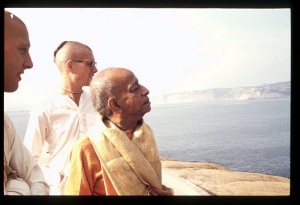CC Adi 13.117 (1975): Difference between revisions
(Vanibot #0027: CCMirror - Mirror CC's 1996 edition to form a basis for 1975) |
(Vanibot #0020: VersionCompareLinker - added a link to the Version Compare feature) |
||
| Line 2: | Line 2: | ||
<div style="float:left">'''[[Sri Caitanya-caritamrta (1975)|Śrī Caitanya-caritāmṛta (1975)]] - [[CC Adi (1975)|Ādi-līlā]] - [[CC Adi 13 (1975)|Chapter 13: The Advent of Lord Śrī Caitanya Mahāprabhu]]'''</div> | <div style="float:left">'''[[Sri Caitanya-caritamrta (1975)|Śrī Caitanya-caritāmṛta (1975)]] - [[CC Adi (1975)|Ādi-līlā]] - [[CC Adi 13 (1975)|Chapter 13: The Advent of Lord Śrī Caitanya Mahāprabhu]]'''</div> | ||
<div style="float:right">[[File:Go-previous.png|link=CC Adi 13.116 (1975)|Ādi-līlā 13.116]] '''[[CC Adi 13.116 (1975)|Ādi-līlā 13.116]] - [[CC Adi 13.118 (1975)|Ādi-līlā 13.118]]''' [[File:Go-next.png|link=CC Adi 13.118 (1975)|Ādi-līlā 13.118]]</div> | <div style="float:right">[[File:Go-previous.png|link=CC Adi 13.116 (1975)|Ādi-līlā 13.116]] '''[[CC Adi 13.116 (1975)|Ādi-līlā 13.116]] - [[CC Adi 13.118 (1975)|Ādi-līlā 13.118]]''' [[File:Go-next.png|link=CC Adi 13.118 (1975)|Ādi-līlā 13.118]]</div> | ||
{{CompareVersions|CC|Adi 13.117|CC 1975|CC 1996}} | |||
{{RandomImage}} | {{RandomImage}} | ||
==== TEXT 117 ==== | ==== TEXT 117 ==== | ||
| Line 13: | Line 12: | ||
:cirajīvī hao dui bhāi | :cirajīvī hao dui bhāi | ||
:ḍākinī-śāṅkhinī haite, śaṅkā upajila cite, | :ḍākinī-śāṅkhinī haite, śaṅkā upajila cite, | ||
:ḍare nāma thuila | :ḍare nāma thuila 'nimāi' | ||
</div> | </div> | ||
| Line 20: | Line 19: | ||
<div class="synonyms"> | <div class="synonyms"> | ||
durvā—fresh grass; dhānya—paddy; dila—gave; śīrṣe—on the head; kaila—did; bahu—with much; āśīṣe—blessing; cira-jīvī—live long; hao—become; dui bhāi—two brothers; ḍākinī-śāṅkhinī—ghosts and witches; haite—from; śaṅkā—doubt; upajila—grew; cite—in the heart; ḍare—out of fear; nāma—name; thuila—kept; nimāi—Lord | durvā—fresh grass; dhānya—paddy; dila—gave; śīrṣe—on the head; kaila—did; bahu—with much; āśīṣe—blessing; cira-jīvī—live long; hao—become; dui bhāi—two brothers; ḍākinī-śāṅkhinī—ghosts and witches; haite—from; śaṅkā—doubt; upajila—grew; cite—in the heart; ḍare—out of fear; nāma—name; thuila—kept; nimāi—Lord Caitanya's childhood name, derived from the nima (nimba) tree. | ||
</div> | </div> | ||
| Line 27: | Line 26: | ||
<div class="translation"> | <div class="translation"> | ||
She blessed the | She blessed the newly born child by placing fresh grass and paddy on His head and saying, "May You be blessed with a long duration of life." But being afraid of ghosts and witches, she gave the child the name Nimāi. | ||
</div> | </div> | ||
| Line 34: | Line 33: | ||
<div class="purport"> | <div class="purport"> | ||
Ḍākinī and Śāṅkhinī are two companions of Lord Śiva and his wife who are supposed to be extremely inauspicious, having been born of ghostly life. It is believed that such inauspicious living creatures cannot go near a nima tree. At least medically it is accepted that nima wood is extremely antiseptic, and formerly it was customary to have a nima tree in front of | Ḍākinī and Śāṅkhinī are two companions of Lord Śiva and his wife who are supposed to be extremely inauspicious, having been born of ghostly life. It is believed that such inauspicious living creatures cannot go near a nima tree. At least medically it is accepted that nima wood is extremely antiseptic, and formerly it was customary to have a nima tree in front of one's house. On very large roads in India, especially in Uttar Pradesh, there are hundreds and thousands of nima trees. Nima wood is so antiseptic that the Āyurvedic science uses it to cure leprosy. Medical scientists have extracted the active principle of the nima tree, which is called margosic acid. Nima is used for many purposes, especially to brush the teeth. In Indian villages ninety percent of the people use nima twigs for this purpose. Because of all the antiseptic effects of the nima tree and because Lord Caitanya was born beneath a nima tree, Sītā Ṭhākurāṇī gave the Lord the name Nimāi. Later in His youth He was celebrated as Nimāi Paṇḍita, and in the neighborhood villages He was called by that name, although His real name was Viśvambhara. | ||
</div> | </div> | ||
Latest revision as of 14:57, 26 January 2020

A.C. Bhaktivedanta Swami Prabhupada
TEXT 117
- durvā, dhānya, dila śīrṣe, kaila bahu āśīṣe,
- cirajīvī hao dui bhāi
- ḍākinī-śāṅkhinī haite, śaṅkā upajila cite,
- ḍare nāma thuila 'nimāi'
SYNONYMS
durvā—fresh grass; dhānya—paddy; dila—gave; śīrṣe—on the head; kaila—did; bahu—with much; āśīṣe—blessing; cira-jīvī—live long; hao—become; dui bhāi—two brothers; ḍākinī-śāṅkhinī—ghosts and witches; haite—from; śaṅkā—doubt; upajila—grew; cite—in the heart; ḍare—out of fear; nāma—name; thuila—kept; nimāi—Lord Caitanya's childhood name, derived from the nima (nimba) tree.
TRANSLATION
She blessed the newly born child by placing fresh grass and paddy on His head and saying, "May You be blessed with a long duration of life." But being afraid of ghosts and witches, she gave the child the name Nimāi.
PURPORT
Ḍākinī and Śāṅkhinī are two companions of Lord Śiva and his wife who are supposed to be extremely inauspicious, having been born of ghostly life. It is believed that such inauspicious living creatures cannot go near a nima tree. At least medically it is accepted that nima wood is extremely antiseptic, and formerly it was customary to have a nima tree in front of one's house. On very large roads in India, especially in Uttar Pradesh, there are hundreds and thousands of nima trees. Nima wood is so antiseptic that the Āyurvedic science uses it to cure leprosy. Medical scientists have extracted the active principle of the nima tree, which is called margosic acid. Nima is used for many purposes, especially to brush the teeth. In Indian villages ninety percent of the people use nima twigs for this purpose. Because of all the antiseptic effects of the nima tree and because Lord Caitanya was born beneath a nima tree, Sītā Ṭhākurāṇī gave the Lord the name Nimāi. Later in His youth He was celebrated as Nimāi Paṇḍita, and in the neighborhood villages He was called by that name, although His real name was Viśvambhara.